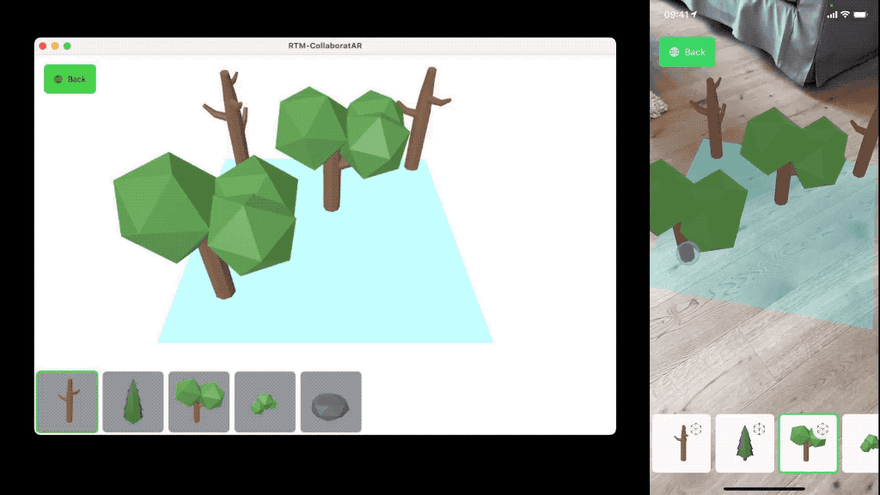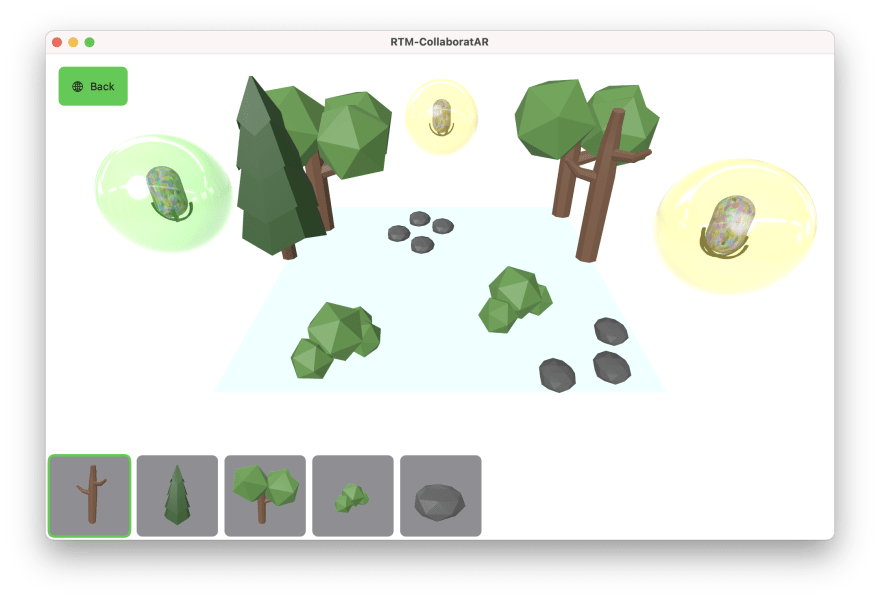Multi-User Collaborative iOS AR Experiences with Agora (Part 1 of 2)

Max Cobb
Posted on August 20, 2021

Agora is much more than a video streaming SDK. One other SDK available from Agora is the Real-time Messaging SDK.
The Agora Real-time messaging SDK can be used to send chunks of data across the network, including encoded structs, files, and plain text.
CollaboratAR is an example project where people can either join an active session or create a new one, located at a place of their choosing on a 3D globe floating in front of them. Once joined, users can add, modify, and remove objects from the scene, with updates sent to everyone else in the channel.
When joining a session, the users also join an audio channel using the Agora Audio SDK, so they can hear each other as well as see each other's location.
This is what the session might look like from the macOS view, which does not have augmented reality:
This post shows you how to use the app to connect with other people around the world. If you want to see how the app is made, go to the follow-up blog post here:

Multi-User Augmented Reality Experiences with Agora (Part 2 of 2)
Max Cobb ・ Aug 20 ・ 11 min read
App Flow
On first launching the app, the user is instructed to find a horizontal surface that the globe will spawn from. After finding a good horizontal surface, the globe is spawned. Any active channels will appear on the globe in the form of red and orange circular targets.
The user can either select one of these targets to join a current room, or create a room by clicking elsewhere on the globe model.
After a user joins a channel, the following things will happen:
- The user will join an audio channel and can hear all other users who have their microphones connected.
- A collection of models appear at the bottom that the user can place in the scene.
- The locations of all remote users appear in the form of a translucent sphere and a visible microphone if their microphones are on.
- Any models that have already been placed into the scene will appear in the place set by other users.
The user can tap on their model of choice and then tap on the scene to place the model anywhere they like. Any placements of objects will be immediately shared with everyone else in the channel at the relevant location of the scene for them.
A user can select a model to delete, scale, rotate, or move it around the scene. These updates are sent across the network. On receiving the update, the local session will animate the object from the old transform to the new one.
Technologies Used
How It Works
To see how the sample app works, you can check out our in-depth blog post on how each part interacts with the Agora Real-time Messaging SDK as well as the Agora Audio SDK:

Multi-User Augmented Reality Experiences with Agora (Part 2 of 2)
Max Cobb ・ Aug 20 ・ 11 min read
The full source code is available here:
 AgoraIO-Community
/
Collaborative-AR-RTM
AgoraIO-Community
/
Collaborative-AR-RTM
A collaborative Augmented Reality iOS experience using Real-time Messaging
What You Can Do with This Technology
Using the techniques outlined in this project, you could create experiences for people to share ideas in augmented reality or virtual reality, as well as in 2D. Anything that someone does on their own device anywhere in the world could easily be represented in another user's experience using the Agora Real-time messaging SDK.
The same techniques could be used to make a multiplayer game, live interactive support, or something more basic, like a live chat feature.
Other Resources
For more information about building applications using the Agora Video and Audio Streaming SDKs, take a look at the Agora Video Call Quickstart Guide and the Agora API Reference.
I also invite you to join the Agora Developer Slack community.

Posted on August 20, 2021
Join Our Newsletter. No Spam, Only the good stuff.
Sign up to receive the latest update from our blog.




